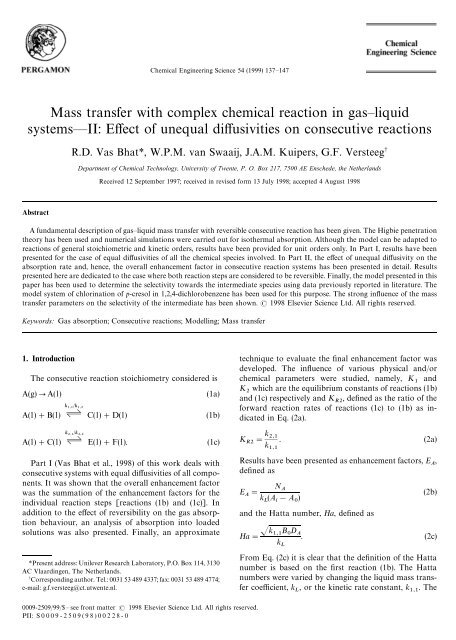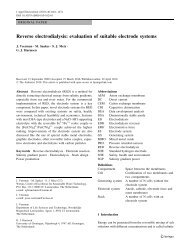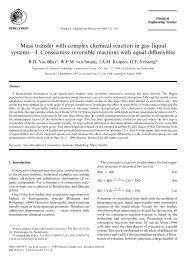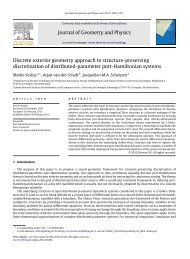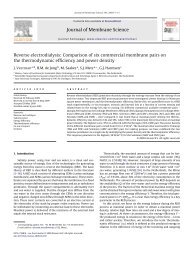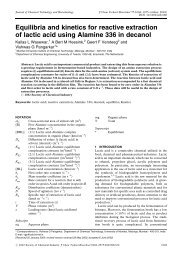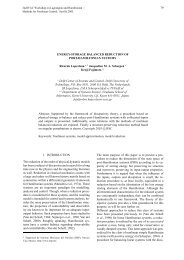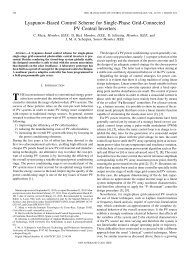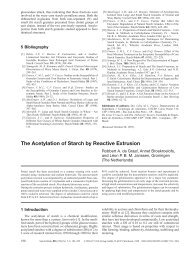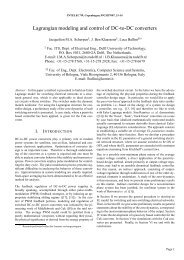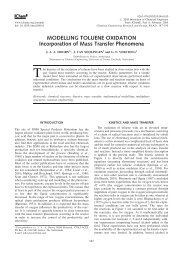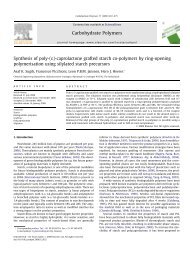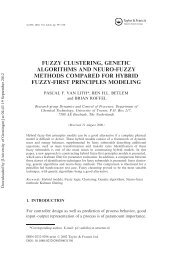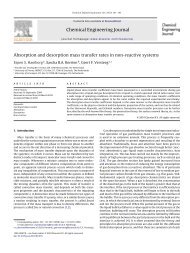Mass transfer with complex chemical reaction in gas—liquid ... - ITM
Mass transfer with complex chemical reaction in gas—liquid ... - ITM
Mass transfer with complex chemical reaction in gas—liquid ... - ITM
- No tags were found...
Create successful ePaper yourself
Turn your PDF publications into a flip-book with our unique Google optimized e-Paper software.
Chemical Eng<strong>in</strong>eer<strong>in</strong>g Science 54 (1999) 137—147<strong>Mass</strong> <strong>transfer</strong> <strong>with</strong> <strong>complex</strong> <strong>chemical</strong> <strong>reaction</strong> <strong>in</strong> <strong>gas—liquid</strong>systems—II: Effect of unequal diffusivities on consecutive <strong>reaction</strong>sR.D. Vas Bhat*, W.P.M. van Swaaij, J.A.M. Kuipers, G.F. Versteeg -Department of Chemical Technology, University of Twente, P. O. Box 217, 7500 AE Enschede, the NetherlandsReceived 12 September 1997; received <strong>in</strong> revised form 13 July 1998; accepted 4 August 1998AbstractA fundamental description of <strong>gas—liquid</strong> mass <strong>transfer</strong> <strong>with</strong> reversible consecutive <strong>reaction</strong> has been given. The Higbie penetrationtheory has been used and numerical simulations were carried out for isothermal absorption. Although the model can be adapted to<strong>reaction</strong>s of general stoichiometric and k<strong>in</strong>etic orders, results have been provided for unit orders only. In Part I, results have beenpresented for the case of equal diffusivities of all the <strong>chemical</strong> species <strong>in</strong>volved. In Part II, the effect of unequal diffusivity on theabsorption rate and, hence, the overall enhancement factor <strong>in</strong> consecutive <strong>reaction</strong> systems has been presented <strong>in</strong> detail. Resultspresented here are dedicated to the case where both <strong>reaction</strong> steps are considered to be reversible. F<strong>in</strong>ally, the model presented <strong>in</strong> thispaper has been used to determ<strong>in</strong>e the selectivity towards the <strong>in</strong>termediate species us<strong>in</strong>g data previously reported <strong>in</strong> literature. Themodel system of chlor<strong>in</strong>ation of p-cresol <strong>in</strong> 1,2,4-dichlorobenzene has been used for this purpose. The strong <strong>in</strong>fluence of the mass<strong>transfer</strong> parameters on the selectivity of the <strong>in</strong>termediate has been shown. 1998 Elsevier Science Ltd. All rights reserved.Keywords: Gas absorption; Consecutive <strong>reaction</strong>s; Modell<strong>in</strong>g; <strong>Mass</strong> <strong>transfer</strong>1. IntroductionThe consecutive <strong>reaction</strong> stoichiometry considered isA(g)PA(l)(1a)A(l)#B(l) ; C(l)#D(l) (1b)A(l)#C(l) ; E(l)#F(l). (1c)Part I (Vas Bhat et al., 1998) of this work deals <strong>with</strong>consecutive systems <strong>with</strong> equal diffusivities of all components.It was shown that the overall enhancement factorwas the summation of the enhancement factors for the<strong>in</strong>dividual <strong>reaction</strong> steps [<strong>reaction</strong>s (1b) and (1c)]. Inaddition to the effect of reversibility on the gas absorptionbehaviour, an analysis of absorption <strong>in</strong>to loadedsolutions was also presented. F<strong>in</strong>ally, an approximate*Present address: Unilever Research Laboratory, P.O. Box 114, 3130AC Vlaard<strong>in</strong>gen, The Netherlands.-Correspond<strong>in</strong>g author. Tel.: 0031 53 489 4337; fax: 0031 53 489 4774;e-mail: g.f.versteeg@ct.utwente.nl.technique to evaluate the f<strong>in</strong>al enhancement factor wasdeveloped. The <strong>in</strong>fluence of various physical and/or<strong>chemical</strong> parameters were studied, namely, K andK which are the equilibrium constants of <strong>reaction</strong>s (1b)and (1c) respectively and K , def<strong>in</strong>ed as the ratio of theforward <strong>reaction</strong> rates of <strong>reaction</strong>s (1c) to (1b) as <strong>in</strong>dicated<strong>in</strong> Eq. (2a).K " k .(2a) k Results have been presented as enhancement factors, E , def<strong>in</strong>ed asE "N (2b) k (A !A ) and the Hatta number, Ha, def<strong>in</strong>ed asHa" k B D . (2c)k From Eq. (2c) it is clear that the def<strong>in</strong>ition of the Hattanumber is based on the first <strong>reaction</strong> (1b). The Hattanumbers were varied by chang<strong>in</strong>g the liquid mass <strong>transfer</strong>coefficient, k , or the k<strong>in</strong>etic rate constant, k . The 0009-2509/99/$— see front matter 1998 Elsevier Science Ltd. All rights reserved.PII: S 0 0 0 9 - 2 5 0 9 ( 9 8 ) 0 0 2 2 8 - 0
138 R.D. Vas Bhat et al./Chemical Eng<strong>in</strong>eer<strong>in</strong>g Science 54 (1999) 137—147Table 1Program <strong>in</strong>put parametersVariable Value UnitsA 10 mol mB 40 mol mk 10—10 msk 0.25—2.610 m mol sK 0.01—100 —K 0.01—100 —K 10—10 —α 10 —D 10 m svariables used <strong>in</strong> the simulations presented <strong>in</strong> this workare given <strong>in</strong> Table 1.In order to ma<strong>in</strong>ta<strong>in</strong> brevity, Part II deals <strong>with</strong> theeffect of a change <strong>in</strong> diffusivity only for the case whereboth <strong>reaction</strong>s (1b) and (1c) are reversible, as it is for thiscase that maximum deviations from the equal diffusivitysituation are observed. S<strong>in</strong>ce this paper aims to understandthe <strong>in</strong>fluence of species diffusivities on the overallmass <strong>transfer</strong> phenomenon, the diffusivity ratios havebeen varied between exaggerated extremes to magnifythese effects. Consequently, these values of diffusion coefficientsshould not be expected to occur <strong>in</strong> real systems,though the effects that they produce may be observed <strong>in</strong>reality.2. Influence of species diffusivityDiffusivity of each <strong>chemical</strong> species has been varied<strong>in</strong>dividually. Results have been presented as a functionof the diffusivity ratio of the species concerned,def<strong>in</strong>ed asr " D D (3)where D is the diffusion coefficient of species ‘i’.2.1. Diffusivity of AOn account of the vast range of calculations possible,only some significant phenomena and/or non-trivial resultshave been elucidated here.The effect of a change <strong>in</strong> the diffusivity of A on themass <strong>transfer</strong> behaviour is shown <strong>in</strong> Fig. 1 where r isvaried between two extreme ratios of 0.1—10 (K "10;K "100). In general, a higher enhancement is observedfor a lower mobility of A. This stems from the fact that,a lower mobility of the gaseous species results <strong>in</strong> a greaterconcentration gradient near the <strong>gas—liquid</strong> <strong>in</strong>terface and,consequently, a higher driv<strong>in</strong>g force. There is a two-step<strong>in</strong>crease <strong>in</strong> the enhancement similar to that observed <strong>in</strong>the case of equal diffusivities. The <strong>in</strong>termediate asymptoticenhancement factor (E ) can be calculated fromstandard methods such as the one presented by DeCourseyand Thr<strong>in</strong>g (1989).2.1.1. Effect of K The effect of K on the mass <strong>transfer</strong> behaviour isobserved <strong>in</strong> Fig. 2(a) and (b) for r "10 and 0.1, respectively(K "100; K "10). As is seen for reversible<strong>reaction</strong>s <strong>with</strong> equal diffusivities, the values of the <strong>in</strong>termediate(E ) and f<strong>in</strong>al enhancement factors (E ) <strong>in</strong>crease<strong>with</strong> K .However, <strong>in</strong> case of a low mobility of A [Fig. 2(b)],some peculiar, not a priori expected, effects are observedfor the case of high K values (typically K "10—100). InFig. 1. Effect of diffusivity of A on enhancement.
R.D. Vas Bhat et al./Chemical Eng<strong>in</strong>eer<strong>in</strong>g Science 54 (1999) 137—147 139Fig. 2. (a) Effect of K on enhancement for high mobility of A (r "10). K "100; K "10. Dashed l<strong>in</strong>e <strong>in</strong>dicates case when both <strong>reaction</strong>s areirreversible. (b) Effect of K on enhancement for low mobility of A (r "0.1). K "100; K "10. Dashed l<strong>in</strong>e <strong>in</strong>dicates case when both <strong>reaction</strong>sare irreversible.the region between E and E , the enhancement factorfor the reversible case is higher than that for both irreversible<strong>reaction</strong>s. This is expla<strong>in</strong>ed by understand<strong>in</strong>g thephenomena occurr<strong>in</strong>g <strong>with</strong><strong>in</strong> the penetration depth oncethe kick-<strong>in</strong> po<strong>in</strong>t has been crossed. Due to the relativelylow diffusivity of A (r "0.1), the <strong>reaction</strong> zone betweenA and B [due to the <strong>in</strong>stantaneous reversible <strong>reaction</strong>1(b)] is formed close to the <strong>in</strong>terface. C and D formed atthis zone can diffuse either towards the <strong>in</strong>terface or to theliquid bulk. The fraction of C that moves towards the<strong>in</strong>terface is <strong>in</strong> a position to react <strong>with</strong> A [via <strong>reaction</strong>(1c)]. In contrast, the fraction of C that diffuses towardsthe liquid bulk can react <strong>with</strong> D via the backward <strong>reaction</strong>(1b) to give back A and B. Hence, the lower mobilityof A is overcome by the transport of A towards the bulk<strong>in</strong> the form of more mobile components, C and D. Inorder to check this hypothesis, various simulations werecarried out for different <strong>in</strong>put parameters, the results ofwhich are presented <strong>in</strong> Table 2. These simulations are fora s<strong>in</strong>gle Hatta number, <strong>in</strong> the transition region betweenE and E . The follow<strong>in</strong>g po<strong>in</strong>ts are of <strong>in</strong>terest: If the hypothesis is correct, the additional enhancementshould not be observed when <strong>reaction</strong> (1b) isirreversible. This is confirmed on compar<strong>in</strong>g cases1 and 2. Conversely, when <strong>reaction</strong> (1b) is reversiblewhile <strong>reaction</strong> (1c) is kept irreversible (case 3) theenhancement rises aga<strong>in</strong>. This clearly <strong>in</strong>dicates that theadditional enhancement observed <strong>in</strong> this region is onaccount of the backward <strong>reaction</strong> of <strong>reaction</strong> (1b). Accord<strong>in</strong>g to the hypothesis, the additional enhancementof A is caused by its <strong>transfer</strong> <strong>in</strong>to the penetrationdepth <strong>in</strong> the form of more mobile components, C andD. Chang<strong>in</strong>g the mobility of C would also affect theenhancement caused by <strong>reaction</strong> (1c). Instead, the mobilityof D has been <strong>in</strong>creased which results <strong>in</strong> higher
140 R.D. Vas Bhat et al./Chemical Eng<strong>in</strong>eer<strong>in</strong>g Science 54 (1999) 137—147Table 2Effect of diffusivity of A on the enhancement factor: K "10; K "100; K "10; k "9.7710 ms; Ha"4096Case r r r r "r (1b) (1c) E 1 0.1 1 1 1 Reversible Reversible 20.532 0.1 1 1 1 Irreversible Reversible 17.313 0.1 1 1 1 Reversible Irreversible 20.984 0.1 1 1 1 Irreversible Irreversible 17.535 0.1 1 10 1 Reversible Reversible 21.136 0.1 1 10 1 Irreversible Reversible 17.317 0.1 1 10 1 Reversible Irreversible 21.558 0.1 1 10 1 Irreversible Irreversible 17.539 0.1 0.1 0.1 1 Reversible Reversible 16.3410 0.1 0.1 0.1 1 Irreversible Reversible 19.7611 0.1 0.1 0.1 1 Reversible Irreversible 16.7512 0.1 0.1 0.1 1 Irreversible Irreversible 20.65enhancement factors (compare cases 1 and 5 and cases3 and 7). This confirms the hypothesis that higherenhancement is obta<strong>in</strong>ed due to the <strong>transfer</strong> of A <strong>in</strong> theform of more mobile species. F<strong>in</strong>ally, <strong>in</strong> order to show that this phenomenon is onlytrue for low mobility of A, the diffusivities of C andD have also been reduced (cases 9—12). As can beexpected, the enhancement factor is higher for the casewhen both <strong>reaction</strong>s are irreversible and the hypothesisis no longer valid.2.2. Diffusivity of CS<strong>in</strong>ce C is both a <strong>reaction</strong> product as well as a reactant,a variation <strong>in</strong> its diffusivity is expected to have a significanteffect on the mass <strong>transfer</strong> behaviour of the system.In order to dist<strong>in</strong>guish between the various underly<strong>in</strong>gphenomena, enhancement factors for two extreme casesof r (0.01 and 10) have been compared (Fig. 3). Thesimulations have been carried out for K " K "100and K "10. Four dist<strong>in</strong>ct regions are observed(named positions I, II, III and IV). Dimensionless concentrationprofiles of all the <strong>chemical</strong> species over thepenetration depth have been presented for each position.The correspond<strong>in</strong>g values of simulation parameters ateach of these positions are given along <strong>with</strong> the figures.2.2.1. Position IS<strong>in</strong>ce this position is before the kick-<strong>in</strong> po<strong>in</strong>t of <strong>reaction</strong>(1c), there is no production of E and F as can be seen <strong>in</strong>Fig. 4(a) and (b). From the figure it is clear that <strong>reaction</strong>(1b) is <strong>in</strong>stantaneous, <strong>in</strong>dicated by the formation of a <strong>reaction</strong>zone between A and B. Thus, near the <strong>in</strong>terface,the concentration of A is governed by the equilibriumconstant, K . At higher r (Fig. 4b), C produced by<strong>reaction</strong> (1b) is <strong>transfer</strong>red faster <strong>in</strong>to the bulk on accountof its greater mobility, thereby reduc<strong>in</strong>g the concentrationof C near the <strong>in</strong>terface. In order to ma<strong>in</strong>ta<strong>in</strong> K constant,the concentration of A near the <strong>in</strong>terface also falls.This <strong>in</strong>creases the concentration gradient of A near the<strong>in</strong>terface and, <strong>in</strong> turn, the enhancement. Conversely, forlow mobility of C [Fig. 4(a)], C formed by <strong>reaction</strong>between A and B rema<strong>in</strong>s near the <strong>in</strong>terface where it<strong>in</strong>creases the concentration of A on account of the equilibriumconstra<strong>in</strong>t. This results <strong>in</strong> a lower enhancement<strong>in</strong> the absorption of A.2.2.2. Position IIAt lower r , the reduced mobility of C prevents it fromdiffus<strong>in</strong>g <strong>in</strong>to the liquid bulk, which causes the concentrationof C near the <strong>in</strong>terface to rise [Fig. 5(a)]. Thismeans that <strong>reaction</strong> (1c) will ‘kick-<strong>in</strong>’ at correspond<strong>in</strong>glylower Hatta numbers as compared to the case <strong>with</strong>a higher r . This is clearly observed <strong>in</strong> Fig. 3 where atposition II, <strong>reaction</strong> (1c) is already <strong>in</strong>fluenc<strong>in</strong>g the mass<strong>transfer</strong> for r "0.01 while its effect is much less forr "10. This is also observed from the concentrationprofiles of E (and F) <strong>in</strong> Fig. 5(a) and (b). For a lowmobility of C (r "0.01), C formed [via <strong>reaction</strong> (1b)]rema<strong>in</strong>s near the <strong>in</strong>terface where it is available for <strong>reaction</strong><strong>with</strong> A [via <strong>reaction</strong> 1(c)]. Due to the high concentrationof C, the absorption rate of A is very high as well,lead<strong>in</strong>g to large enhancement. For a high mobility ofC(r "10), C can diffuse away from the <strong>in</strong>terface so thatits <strong>in</strong>terfacial concentration is low (as compared to r "0.01) and, hence, the absorption rate of A is also low.2.2.3. Position IIIOn <strong>in</strong>creas<strong>in</strong>g the Hatta number from position II toposition III (Fig. 3), there is an <strong>in</strong>crease <strong>in</strong> enhancementdue to the <strong>reaction</strong> between C and A via <strong>reaction</strong> (1c).For a low r , C is formed by <strong>reaction</strong> (1b) away from the<strong>in</strong>terface. A fraction of this C formed diffuses towards the<strong>in</strong>terface where it reacts <strong>with</strong> A. At lower Hatta numbers(closer to position II), the diffusion rate is sufficient tosupply <strong>reaction</strong> (1c). As the Hatta number is <strong>in</strong>creased
R.D. Vas Bhat et al./Chemical Eng<strong>in</strong>eer<strong>in</strong>g Science 54 (1999) 137—147 141Fig. 3. Effect of diffusivity of C on enhancement. K "K "100; K "10.Fig. 4. (a) Concentration profiles at position I: r "0.01. Profiles at end of the contact time. Ha"45.2; E "4.47. (b) Concentration profiles atposition I: r "10. Profiles at end of the contact time. Ha"45.2; E "4.91.
R.D. Vas Bhat et al./Chemical Eng<strong>in</strong>eer<strong>in</strong>g Science 54 (1999) 137—147 143Fig. 6. (a) Concentration profiles at position III: r "0.01. Profiles at end of the contact time. Ha"5790; E "8.19. (b) Concentration profiles atposition III: r "10. Profiles at end of the contact time. Ha"5790; E "7.99.K , determ<strong>in</strong>e the concentrations of all components. Fora case of lower mobility of C [r "0.01; Fig. 7(a)], concentrationof C near the <strong>in</strong>terface is very low due to thetransport limitation of C towards the <strong>in</strong>terface. Thiscomb<strong>in</strong>ed <strong>with</strong> the high concentration of E (and F) nearthe <strong>in</strong>terface forces the concentration of A to rise <strong>in</strong> thevic<strong>in</strong>ity of the <strong>in</strong>terface, which opposes the absorption ofA and reduces the enhancement factor. In order to verifythis hypothesis, simulations <strong>with</strong> identical process parametersand <strong>with</strong> <strong>reaction</strong> (1c) ma<strong>in</strong>ta<strong>in</strong>ed irreversiblewere carried out (Fig. 8). The enhancement factor, <strong>in</strong> thiscase, does not reduce beyond position III, confirm<strong>in</strong>gthat the reduction <strong>in</strong> the case of lower mobility is causedby the equilibrium constra<strong>in</strong>t of <strong>reaction</strong> (1c).This effect is not observed for higher mobilities[r "10; Fig. 7(b)], as the concentration of C near the<strong>in</strong>terface is higher (than r "0.01). This prevents an <strong>in</strong>crease<strong>in</strong> the concentration of A near the <strong>in</strong>terface eventhough the concentration of <strong>reaction</strong> products E (and F)may be high. Consequently, the <strong>in</strong>f<strong>in</strong>ite enhancementreached <strong>with</strong> high r is greater than that <strong>with</strong> a lower r .3. Influence of mass <strong>transfer</strong> factors on selectivityA number of examples of gas absorption <strong>with</strong> consecutive<strong>reaction</strong> are found <strong>in</strong> the organic process <strong>in</strong>dustry,namely the halogenation, alkylation and oxidation ofaromatic compounds. In all these cases, the selectivitytowards a particular product is desired. It has beenshown earlier (van de Vusse, 1966a, b; Hashimoto et al.,1968) that the mass <strong>transfer</strong> factors, such as k , cansignificantly <strong>in</strong>fluence selectivity <strong>in</strong> systems <strong>in</strong>volv<strong>in</strong>gconsecutive <strong>reaction</strong>s. For a review of previous research
144 R.D. Vas Bhat et al./Chemical Eng<strong>in</strong>eer<strong>in</strong>g Science 54 (1999) 137—147Fig. 7. (a) Concentration profiles at position IV: r "0.01. Profiles at end of the contact time. Ha"1.3110; E "7.12. (b) Concentration profiles atposition IV: r "10. Profiles at end of the contact time. Ha"1.3110; E "10.13.determ<strong>in</strong><strong>in</strong>g selectivity <strong>in</strong> consecutive <strong>reaction</strong> systems,the reader is referred to Darde et al. (1983). In order tovalidate the theoretical predictions of selectivity, experiments<strong>with</strong> different model <strong>reaction</strong> systems have beencarried out <strong>in</strong> the past. van de Vusse (1966) used thechlor<strong>in</strong>ation of n-decane. However, <strong>in</strong> order to limit thenumber of by-products, the chlor<strong>in</strong>ation of p-cresol wassubsequently used (Teramoto et al., 1970; Pangarkar andSharma, 1974; Darde et al., 1984).(4a)(4b)The flux model described <strong>in</strong> this paper has been usedto determ<strong>in</strong>e differential selectivity for the chlor<strong>in</strong>ation ofp-cresol <strong>in</strong> 1,2,4-trichlorobenzene. The <strong>reaction</strong> schemeconsidered is given by <strong>reaction</strong> (4a) and (4b). The productionof the <strong>in</strong>termediate product, monochloro-p-cresol(MCPC) should be maximised, whereas that of the undesireddichloro-p-cresol (DCPC) should be as low as possible.The <strong>in</strong>put data for the same has been taken fromPangarkar and Sharma (1974), see Table 3. S<strong>in</strong>ce no
R.D. Vas Bhat et al./Chemical Eng<strong>in</strong>eer<strong>in</strong>g Science 54 (1999) 137—147 145Fig. 8. Effect of irreversibility of <strong>reaction</strong> (1c) on enhancement for low mobility of C.Table 3Input parameters for chlor<strong>in</strong>ation of p-cresol <strong>in</strong> 1,2,4-trichlorobenzene(simulation results presented <strong>in</strong> Fig. 9)Parameter Value Units¹ 373.15 K[Cl ] 270 mol m[p-cresol] 4000 mol mk 0.19 m mol sk 0.015 m mol sD 5.410 m sD 3.910 m sD 3.310 m sk 10—10 ms(Taken from Pangarkar and Sharma, 1974).Liquid phase assumed to be unloaded.<strong>in</strong>formation of equilibrium constants for the system isavailable, both <strong>reaction</strong>s are assumed to be irreversible.By vary<strong>in</strong>g the mass <strong>transfer</strong> coefficient, k , the Hattanumber has been changed over a wide range (0.01(Ha(10) which covers all regimes of mass <strong>transfer</strong>. Thefully developed concentration profiles (at the end of theHigbie contact time) of p-cresol, MCPC and DCPC, werenumerically <strong>in</strong>tegrated over the penetration depth toobta<strong>in</strong> the average concentration of each species. TheSimpson’s 1/3rd rule was used for this purpose. Thesevalues were used to determ<strong>in</strong>e the differential selectivity,σ, and the overall conversion of p-cresol, ζ, def<strong>in</strong>ed as:σ" [MCPC](5a)[DCPC]ζ(%)" 1![p!cresol] (5b)where the square parenthesis <strong>in</strong>dicate concentrations. Itis important to note that the parameters, σ and ζ, arebased on concentrations <strong>with</strong><strong>in</strong> the liquid package and<strong>with</strong><strong>in</strong> a s<strong>in</strong>gle contact time.The variation of σ and ζ <strong>with</strong> the Hatta number hasbeen presented <strong>in</strong> Fig. 9. A significant <strong>in</strong>fluence of themass <strong>transfer</strong> parameters on selectivity is observed. Thishas been reported earlier, among others, by van de Vusse(1966a, b), Teramoto et al. (1970) and Pangarkar andSharma (1974). At high k values, correspond<strong>in</strong>g to lowHatta numbers, the rate of mass <strong>transfer</strong> is much greaterthan the k<strong>in</strong>etic rate so that the overall absorption isdeterm<strong>in</strong>ed by the rate of <strong>reaction</strong> (4a). As the Hattanumber <strong>in</strong>creases, the extent of <strong>reaction</strong> (4b) <strong>in</strong>creases aswell, thereby <strong>in</strong>creas<strong>in</strong>g the formation of DCPC. This, <strong>in</strong>turn, steadily reduces the selectivity towards MCPC.However, the production of MCPC is attractive only atsignificant conversions of p-cresol. As expected, the conversioncurve <strong>in</strong>creases <strong>with</strong> Hatta number as it dependsdirectly on the <strong>reaction</strong> between Cl and p-cresol [<strong>reaction</strong>(4a)]. Thus, <strong>in</strong>creas<strong>in</strong>g the Hatta number <strong>in</strong>creasesthe enhancement, that <strong>in</strong> turn <strong>in</strong>fluences conversion dueto the greater availability of Cl <strong>in</strong> the penetration depth.In actual operation a compromise will have to be metbetween maximis<strong>in</strong>g selectivity on the one hand andconversion on the other. It is <strong>in</strong>terest<strong>in</strong>g to note that theconversion curve does not form an <strong>in</strong>termediate plateauas is expected of consecutive <strong>reaction</strong> schemes. This isbecause at the process temperature (100°C), the value ofK is rather high (&810) so that <strong>reaction</strong> (4b)kicks-<strong>in</strong> even before <strong>reaction</strong> (4a) has reached its <strong>in</strong>f<strong>in</strong>iteenhancement value.4. ConclusionsA fundamental description of <strong>gas—liquid</strong> mass <strong>transfer</strong>for isothermal reversible consecutive <strong>reaction</strong>s has been
146 R.D. Vas Bhat et al./Chemical Eng<strong>in</strong>eer<strong>in</strong>g Science 54 (1999) 137—147Fig. 9. Variation of selectivity, σ, and conversion, ζ, <strong>with</strong> Hatta number. Chlor<strong>in</strong>ation of p-cresol <strong>in</strong> 1,2,4-trichlorobenzene. Input data given <strong>in</strong> Table 3.Average concentrations determ<strong>in</strong>ed at end of contact time.Table 4Selection of enhancement factors at different Hatta numbers (additional parameters given <strong>in</strong> Table 1 and the respective figures)Figure Ha E r "0.1 r "5 r "101 4 3.60 2.48 2.37128 10.47 2.80 2.581024 13.80 3.81 3.51741460 25.27 5.11 4.43K "0.1 K "10 K "100 2(a) 4 1.36 2.37 2.60r "10 128 1.38 2.58 3.001024 1.79 3.51 3.87741460 3.17 4.43 4.53K "0.1 K "10 K "100 2(b) 4 2.32 3.60 3.66r "0.1 128 3.06 10.47 12.611024 3.98 13.80 14.79741460 17.02 25.27 25.35presented. Results for the case where both <strong>reaction</strong>s arereversible have been presented for unequal diffusivities ofthe <strong>chemical</strong> species.Of the various <strong>chemical</strong> species present, variations <strong>in</strong>the diffusivity of two of them show a significant effect onthe overall mass <strong>transfer</strong> behaviour. These are essentially,the gas-phase component and the <strong>in</strong>termediate formedby the first <strong>reaction</strong>.In the case of variation <strong>in</strong> the diffusivity of A, it hasbeen shown that for low mobility, the enhancement forthe case <strong>with</strong> both <strong>reaction</strong>s reversible can be higher thanthat for the case <strong>with</strong> both <strong>reaction</strong>s irreversible. This isexpla<strong>in</strong>ed by the fact that species A is transported <strong>with</strong><strong>in</strong>the penetration depth <strong>in</strong> the form of other, more mobile,components.In case of the <strong>in</strong>termediate, C, it is observed that the<strong>in</strong>fluence of the second <strong>reaction</strong> (1c) on the overall enhancementis observed at lower Hatta numbers fora lower mobility of C. Beyond the <strong>in</strong>termediate enhancementvalue, the overall enhancement is determ<strong>in</strong>ed bytwo oppos<strong>in</strong>g factors. Forward <strong>reaction</strong> of <strong>reaction</strong> (1c)<strong>in</strong>creases the enhancement. As the Hatta number is <strong>in</strong>creasedfurther, the backward <strong>reaction</strong> (1c) prevailswhich forces the enhancement to reduce. For low mobilityof the <strong>in</strong>termediate, it has been shown that theseoppos<strong>in</strong>g effects cause a maximum <strong>in</strong> the enhancement
R.D. Vas Bhat et al./Chemical Eng<strong>in</strong>eer<strong>in</strong>g Science 54 (1999) 137—147 147curve before approach<strong>in</strong>g the f<strong>in</strong>al <strong>in</strong>f<strong>in</strong>ite enhancementfactor.F<strong>in</strong>ally, the model presented <strong>in</strong> this paper has beenused to determ<strong>in</strong>e differential selectivity towards the <strong>in</strong>termediate<strong>in</strong> the consecutive <strong>reaction</strong> scheme. Experimentaldata presented previously by Pangarkar andSharma (1974) for the chlor<strong>in</strong>ation of p-cresol have beenused for this purpose. As has been reported earlier,a strong <strong>in</strong>fluence of mass <strong>transfer</strong> parameters on theselectivity of the <strong>in</strong>termediate was observed <strong>with</strong> selectivityreduc<strong>in</strong>g <strong>with</strong> an <strong>in</strong>crease <strong>in</strong> Hatta number. In practice,however, a compromise needs to be reached betweenselectivity towards the <strong>in</strong>termediate on the one hand andconversion on the other. Due to lack of comprehensivedata such as equilibrium constants, the full potential ofthe model could not be exploited.The present model provides a rigorous mathematicalanalysis of the consecutive <strong>reaction</strong> system under conditionsof unequal diffusivity. With a view of encourag<strong>in</strong>gfurther numerical and/or approximate exam<strong>in</strong>ation ofthis <strong>reaction</strong> scheme, a selection of results (obta<strong>in</strong>ed <strong>with</strong>this model) has been presented <strong>in</strong> Table 4.AcknowledgementsThe authors wish to thank Akzo Nobel Central Research(the Netherlands) for their f<strong>in</strong>ancial support tothis <strong>in</strong>vestigation and A.P. Higler for his assistance <strong>in</strong> thenumerical solution of the model.NotationA component A, concentration of componentA, mol mA total A <strong>in</strong> all forms ("A #D #E ), dimensionless B component B, concentration of component B,mol mB total B <strong>in</strong> all forms ("B #D ), dimensionless C component C, concentration of componentC, mol mD component D, concentration of componentD, mol mD diffusivity, sub: component, m sE component E, concentration of component E,mol mE enhancement factor, def<strong>in</strong>ed by <strong>reaction</strong> (2b),dimensionlessE f<strong>in</strong>al <strong>in</strong>f<strong>in</strong>ite enhancement factor, dimensionlessE <strong>in</strong>termediate asymptotic enhancement factor,dimensionlessHa Hatta number, def<strong>in</strong>ed by <strong>reaction</strong> (2c), dimensionlessK K k k N r equilibrium constant, sub: <strong>reaction</strong> number,dimensionlessk /k , dimensionless <strong>reaction</strong> rate constantsub1: <strong>reaction</strong> number, sub2: <strong>reaction</strong> direction,m mol sliquid-side mass <strong>transfer</strong> coefficient, m sgas flux, mol m sdiffusivity ratio, def<strong>in</strong>ed by D /D , sub: component, dimensionlessGreek lettersα load<strong>in</strong>g factor ("A /B ), dimensionless σ differential selectivity, def<strong>in</strong>ed by Eq. (5a), dimensionlessζ conversion of p-cresol, def<strong>in</strong>ed by Eq. (5b),dimensionlessSubscripts0 <strong>in</strong>itial conditionG, g gas phasei <strong>in</strong>terface¸, l liquid phasered reduced¹ totalAbbreviationsMCPC monochloro-p-cresolDCPC dichloro-p-cresolReferencesDarde, T., Midoux, N., & Charpentier, J.C. (1983). Contribution to theanalysis of the selectivity <strong>in</strong> <strong>gas—liquid</strong> <strong>reaction</strong> part I: literature andtheory. Chem. Engng Commun., 22, 221—241.Darde, T., Midoux, N., & Charpentier, J.C. (1984). Contribution to theanalysis of the selectivity of <strong>gas—liquid</strong> <strong>reaction</strong>s part II: comparisonof experimental results <strong>with</strong> model predictions. Chem. Engng Commun.,26, 33—54.DeCoursey, W.J., & Thr<strong>in</strong>g, R.W. (1989). Effects of unequal diffusivitieson enhancement factors for reversible and irreversible <strong>reaction</strong>.Chem. Engng Sci., 44, 1715—1721.Hashimoto, K., Teramoto, M., Nagayasu, T., & Nagata, S. (1968). Theeffects of mass <strong>transfer</strong> on the selectivity of <strong>gas—liquid</strong> <strong>reaction</strong>s. J.Chem. Engng (Japan), 1, 132—138.Pangarkar, V.G., & Sharma, M.M. (1974). Consecutive <strong>reaction</strong>s: roleof mass <strong>transfer</strong> factors. Chem. Engng Sci., 29, 561—569.Teramoto, M., Fujita, S., Kataoka, M., Hashimoto, K., & Nagata, S.(1970). Effect of bubble size on the selectivity of consecutive<strong>gas—liquid</strong> <strong>reaction</strong>s. J. Chem. Engng (Japan), 3, 79—82.Vas Bhat, R.D., van Swaaij, W.P.M., Kuipers, J.A.M., & Versteeg, G.F.,<strong>Mass</strong> <strong>transfer</strong> <strong>with</strong> <strong>complex</strong> <strong>chemical</strong> <strong>reaction</strong> <strong>in</strong> <strong>gas—liquid</strong> systems—partI: consecutive reversible <strong>reaction</strong>s <strong>with</strong> equal diffusivities.Chem. Engng Sci., 54, 121—136.Vusse, J.G. van de (1966a). Consecutive <strong>reaction</strong>s <strong>in</strong> heterogeneoussystems I—the effect of mass <strong>transfer</strong> on selectivity. Chem. EngngSci., 21, 631—643.Vusse, J.G. van de (1966b). Consecutive <strong>reaction</strong>s <strong>in</strong> heterogeneoussystems II—<strong>in</strong>fluence of order of <strong>reaction</strong> rates on selectivity. Chem.Engng Sci., 21, 645—654.


